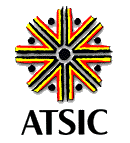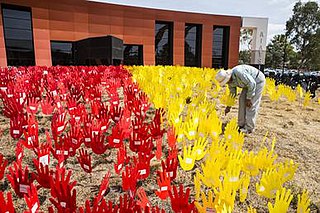Related Research Articles

The Aboriginal and Torres Strait Islander Commission (ATSIC) (1990–2005) was the Australian Government body through which Aboriginal Australians and Torres Strait Islanders were formally involved in the processes of government affecting their lives. A number of Indigenous programs and organisations fell under the overall umbrella of ATSIC.

Central Queensland is an ambiguous geographical division of Queensland that centres on the eastern coast, around the Tropic of Capricorn. Its major regional centre is Rockhampton. The region extends from the Capricorn Coast west to the Central Highlands at Emerald, north to the Mackay Regional Council southern boundary, and south to Gladstone. The region is also known as Capricornia. It is one of Australia's main coal exporting regions.

The second part of the 1967 Australian referendum related to Aboriginal people. The 1967 Australian referendum, called by the Holt Government on 27 May 1967, consisted of two parts, with the first question relating to Aboriginal Australians. It asked for approval for two amendments to the Australian constitution based on this second question. The amendments related to counting Aboriginal people in the Australian census, and allowing the government to legislate separately for Aboriginal people. Technically this referendum question was a vote on the Constitution Alteration (Aboriginals) Act 1967, which became law on 10 August 1967 following the results of the referendum.
The National Archives of Australia is an Australian Government agency that collects, preserves and encourages access to important Australian Government records. It describes itself as the memory of the nation.

The Australian Institute of Aboriginal and Torres Strait Islander Studies (AIATSIS) is an independent Australian Government statutory authority. It is a collecting, publishing and research institute and is considered to be Australia's premier resource for information about the cultures and societies of Aboriginal and Torres Strait Islander peoples. The Institute is a leader in ethical research and the handling of culturally sensitive material and holds in its collections many unique and irreplaceable items of cultural, historical and spiritual significance. The collection at AIATSIS has been built through over 50 years of research and engagement with Aboriginal and Torres Strait Islander communities and is now a source of language and culture revitalisation, native title research and family and community history. AIATSIS is located on Acton Peninsula in Canberra, Australian Capital Territory.

The South Australian Museum is a natural history museum and research institution in Adelaide, South Australia, founded in 1856 and owned by the Government of South Australia. It occupies a complex of buildings on North Terrace in the cultural precinct of the Adelaide Parklands. Plans are under way to split its Australian Aboriginal cultural collection, some of which will be housed in a new building housing these along with other works of art, in a new National Gallery for Aboriginal Art and Cultures.
Although Australia has no official languages, English has been entrenched as the de facto national language since European settlement. Australian English is a major variety of the language with a distinctive pronunciation and lexicon, and differs slightly from other varieties of English in grammar and spelling. General Australian serves as the standard dialect.

Coconut Island, Poruma Island, or Puruma in the local language, is an island in the Great North East Channel near Cumberland Passage, Torres Strait, Queensland, Australia. One of the Torres Strait Islands, Coconut Island is 130 kilometres (81 mi) northeast of Thursday Island. Administratively, Coconut Island is a town and Poruma Island is the locality within the Shire of Torres.
Indigenous Australians are people who are descended from groups that lived in Australia and surrounding islands before British colonisation. They include the Aboriginal and Torres Strait Islander peoples of Australia. The term Aboriginal and Torres Strait Islander people is preferred by many; First Nations of Australia, First Peoples of Australia and First Australians are also increasingly common terms.
Australian heritage laws exist at the National (Commonwealth) level, and at each of Australian Capital Territory, New South Wales, Northern Territory, Queensland, South Australia, Tasmania, Victoria, Western Australia State and Territory levels. Generally there are separate laws governing Aboriginal cultural heritage and historical heritage. State laws also allow heritage to be protected through Local Government regulations, such as planning schemes, as well.
The Aboriginal Heritage Act 1988 is the principal South Australian legislation protecting and preserving the state's Aboriginal heritage.

An Indigenous Protected Area (IPA) is a class of protected area used in Australia; each is formed by agreement with Indigenous Australians, and declared by Indigenous Australians. Each is formally recognised by the Australian Government as being part of its National Reserve System, with 75 IPAs comprising more than 44% of the national reserve land, occupying about 67,000,000 hectares as of April 2020.

The Gulf Country is the region of woodland and savanna grassland surrounding the Gulf of Carpentaria in north western Queensland and eastern Northern Territory on the north coast of Australia. The region is also called the Gulf Savannah. It contains large reserves of zinc, lead and silver. The Gulf Country is crossed by the Savannah Way highway.
Peter George Dodd was an Australian politician. He was an Australian Labor Party member of the Australian House of Representatives from 1993 to 1996, representing the Queensland seat of Leichhardt.

Trove is an Australian online library database aggregator; a free faceted-search engine hosted by the National Library of Australia, in partnership with content providers including members of the National & State Libraries Australasia. It is one of the most well-respected and accessed GLAM services in Australia, with over 70,000 daily users.
Bidjara is an Australian Aboriginal language. In 1980, it was spoken by twenty elders in Queensland between the towns of Tambo and Augathella, or the Warrego and Langlo rivers. The language is being revitalised and is being taught in local schools in the region.
The National Aboriginal and Torres Strait Islander Social Survey (NATSISS) is a statistical survey administered by the Australian Bureau of Statistics which collects information on the social situation of Indigenous Australians, including on health, education, culture and labour force participation. The surveys are carried out every six years, starting in 2002. It succeeded the National Aboriginal and Torres Strait Islander Survey (NATSIS), the last survey of which was carried out in 1994.
Indigenous Australians are both convicted of crimes and imprisoned at a disproportionately high rate in Australia, as well as being over-represented as victims of crime. The issue is a complex one, to which federal and state governments as well as Indigenous groups have responded with various analyses and numerous programs and measures. As of September 2019, Aboriginal and Torres Strait Islander prisoners represented 28% of the total adult prisoner population, while accounting for 3.3% of the general population.

Kaurareg is the name for one of the Indigenous Australian groups collectively known as Torres Strait Islander peoples. They are lower Western Islanders, based on the Muralag group. In common with the other peoples of the Torres Strait Island, they commanded impressive sailing outrigger canoe technology, traded throughout the Straits, fishing and trading with other Torres Strait Island groups. Similarly, they also regularly visited the Australian mainland of Cape York Peninsula, and retained ceremonial, marriage and trading alliances with several Aboriginal Australian groups there. Subject to reprisals after being blamed for an incident in which a Western schooner and its crew were destroyed, their numbers rapidly diminished with the onset of white colonisation and administration. After World War II, descendants of the Kaurareg began to return to their traditional islands, and lay claim to native title over several of them.
The Australian Web Archive is an publicly available online database of archived Australian websites. It which comprises the PANDORA Archive, the Australian Government Web Archive (AGWA) and the National Library's ".au" domain collections. Access is through a single interface in Trove which is publicly available.
References
- ↑ "History and Achievements". PANDORA. 18 February 2009.
- ↑ "Selection Guidelines". PANDORA. 13 September 2013. Retrieved 17 March 2014.
- ↑ "WHAT IS LEGAL DEPOSIT?". National Library of Australia. Retrieved 2 February 2014.
- ↑ "NOTICE TO PUBLISHER OF ONLINE MATERIAL". National Library of Australia. Retrieved 2 February 2014.
- ↑ "PANDORA Digital Archiving System (PANDAS)". PANDORA. 20 February 2009.
- ↑ Whiting, Julie (August 2000). "New look marks milestone for PANDORA Tour de Force". National Library of Australia: Gateways. National Library of Australia. Archived from the original on 24 May 2004. Retrieved 17 March 2014.
- ↑ "NLA Selection Guidelines". Pandora Archive. 5 June 2018. Retrieved 30 April 2020.
- ↑ "Pandora Archive". Australian Institute of Aboriginal and Torres Strait Islander Studies. Retrieved 30 April 2020.
- ↑ "Other archives". Pandora Archive. 24 August 2011. Retrieved 30 April 2020.
- ↑ "Preserving and Accessing Networked DOcumentary Resources of Australia". Pandora Archive. Retrieved 30 April 2020.
- ↑ "Australian web archive". Trove. Retrieved 30 April 2020.
- ↑ "Archived websites". National Library of Australia. 23 March 2020. Retrieved 30 April 2020.
- ↑ Koerbin, Paul (11 February 2015). "The Australian Government Web Archive". National Library of Australia. Retrieved 30 April 2020.
- ↑ "Statistics". Pandora Archive. 26 February 2020. Retrieved 30 April 2020.